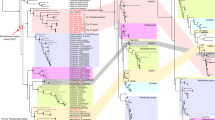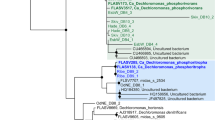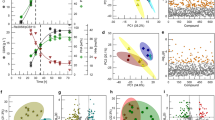Abstract
Members of the genus Tetrasphaera are considered to be putative polyphosphate accumulating organisms (PAOs) in enhanced biological phosphorus removal (EBPR) from wastewater. Although abundant in Danish full-scale wastewater EBPR plants, how similar their ecophysiology is to ‘Candidatus Accumulibacter phosphatis’ is unclear, although they may occupy different ecological niches in EBPR communities. The genomes of four Tetrasphaera isolates (T. australiensis, T. japonica, T. elongata and T. jenkinsii) were sequenced and annotated, and the data used to construct metabolic models. These models incorporate central aspects of carbon and phosphorus metabolism critical to understanding their behavior under the alternating anaerobic/aerobic conditions encountered in EBPR systems. Key features of these metabolic pathways were investigated in pure cultures, although poor growth limited their analyses to T. japonica and T. elongata. Based on the models, we propose that under anaerobic conditions the Tetrasphaera-related PAOs take up glucose and ferment this to succinate and other components. They also synthesize glycogen as a storage polymer, using energy generated from the degradation of stored polyphosphate and substrate fermentation. During the aerobic phase, the stored glycogen is catabolized to provide energy for growth and to replenish the intracellular polyphosphate reserves needed for subsequent anaerobic metabolism. They are also able to denitrify. This physiology is markedly different to that displayed by ‘Candidatus Accumulibacter phosphatis’, and reveals Tetrasphaera populations to be unusual and physiologically versatile PAOs carrying out denitrification, fermentation and polyphosphate accumulation.
Similar content being viewed by others
Log in or create a free account to read this content
Gain free access to this article, as well as selected content from this journal and more on nature.com
or
Accession codes
Accessions
GenBank/EMBL/DDBJ
References
Akiyama M, Crooke E, Kornberg A . (1992). The polyphosphate kinase gene of Escherichia coli. Isolation and sequence of the ppk gene and membrane location of the protein. J Biol Chem 267: 22556–22561.
Akiyama M, Crooke E, Kornberg A . (1993). An exopolyphosphatase of Escherichia coli. The enzyme and its ppx gene in a polyphosphate operon. J Biol Chem 268: 633–639.
Albertsen M, Hansen LBS, Saunders AM, Nielsen PH, Nielsen KL . (2011). A metagenome of a full-scale microbial community carrying out enhanced biological phosphorus removal. ISME J 6: 1094–1106.
APHA, AWWA, WPCF (1995) Standard Methods for the Examination of Water and Wastewater. Port City Press: Baltimore.
Barnard JL . (1975). Biological nutrient removal without the addition of chemicals. Water Res 9: 485–490.
Bentley S . (2009). Sequencing the species pan-genome. Nature Rev Microbiol 7: 258–259.
Blackall LL, Seviour EM, Bradford D, Rossetti S, Tandoi V, Seviour RJ . (2000). ‘Candidatus Nostocoida limicola’, a filamentous bacterium from activated sludge. Int J Syst Evol Microbiol 50: 703–709.
Bond PL, Erhart R, Wagner M, Keller J, Blackall LL . (1999). Identification of some of the major groups of bacteria in efficient and nonefficient biological phosphorus removal activated sludge systems. Appl Environ Microbiol 65: 4077–4084.
Bonting CF, Kortstee GJ, Zehnder AJ . (1991). Properties of polyphosphate: AMP phosphotransferase of Acinetobacter strain 210A. J Bacteriol 173: 6484–6488.
Braunegg G, Sonnleitner B, Lafferty RM . (1978). A rapid gas chromatographic method for the determination of poly-β-hydroxybutyric acid in microbial biomass. Eur J Appl Microbiol Biotechnol 6: 29–37.
Burow LC, Mabbett AN, Blackall LL . (2008). Anaerobic glyoxylate cycle activity during simultaneous utilization of glycogen and acetate in uncultured Accumulibacter enriched in enhanced biological phosphorus removal communities. ISME J 2: 1040–1051.
Clark DP . (1989). The fermentation pathways of Escherichia coli. FEMS Microbiol Rev 5: 223–234.
Comeau Y, Hall KJ, Hancock REW, Oldham WK . (1986). Biochemical model for enhanced biological phosphorus removal. Water Res 20: 1511–1521.
Crocetti GR, Hugenholtz P, Bond PL, Schuler A, Keller J, Jenkins D et al (2000). Identification of polyphosphate-accumulating organisms and design of 16S rRNA-directed probes for their detection and quantitation. Appl Environ Microbiol 66: 1175–1182.
Farrer RA, Kemen E, Jones JDG, Studholme DJ . (2009). De novo assembly of the Pseudomonas syringae pv.syringae B728a genome using Illumina/Solexa short sequence reads. FEMS Microbiol Lett 291: 103–111.
Flowers JJ, He S, Yilmaz S, Noguera DR, McMahon KD . (2009). Denitrification capabilities of two biological phosphorus removal sludges dominated by different ’Candidatus Accumulibacter’ clades. Environ Microbiol Rep 1: 583–588.
Fuhs GW, Chen M . (1975). Microbiological basis of phosphate removal in the activated sludge process for the treatment of wastewater. Microb Ecol 2: 119–138.
García Martín H, Ivanova N, Kunin V, Warnecke F, Barry KW, McHardy AC et al (2006). Metagenomic analysis of two enhanced biological phosphorus removal (EBPR) sludge communities. Nat Biotechnol 24: 1263–1269.
Hanada S, Liu WT, Shintani T, Kamagata Y, Nakamura K . (2002). Tetrasphaera elongata sp. nov., a polyphosphate-accumulating bacterium isolated from activated sludge. Int J Syst Evol Microbiol 52: 883.
He S, Kunin V, Haynes M, Martin HG, Ivanova N, Rohwer F et al (2010). Metatranscriptomic array analysis of ’Candidatus Accumulibacter phosphatis’-enriched enhanced biological phosphorus removal sludge. Environ Microbiol 12: 1205–1217.
He S, McMahon K . (2011). ‘Candidatus Accumulibacter’ gene expression in response to dynamic EBPR conditions. ISME J 5: 329–340.
Hesselmann RPX, Von Rummell R, Resnick SM, Hany R, Zehnder AJB . (2000). Anaerobic metabolism of bacteria performing enhanced biological phosphate removal. Water Res 34: 3487–3494.
Ishige K, Zhang H, Kornberg A . (2002). A polyphosphate kinase (PPK2) widely conserved in bacteria. Proc Natl Acad Sci USA 99: 16678–16683.
Kong Y, Nielsen JL, Nielsen PH . (2004). Microautoradiographic study of Rhodocyclus-related polyphosphate-accumulating bacteria in full-scale enhanced biological phosphorus removal plants. Appl Environ Microbiol 70: 5383–5390.
Kong Y, Nielsen JL, Nielsen PH . (2005). Identity and ecophysiology of uncultured actinobacterial polyphosphate-accumulating organisms in full-scale enhanced biological phosphorus removal plants. Appl Environ Microbiol 71: 4076–4085.
Kong Y, Xia Y, Nielsen PH . (2008). Activity and identity of fermenting microorganisms in full-scale biological nutrient removing wastewater treatment plants. Environ Microbiol 10: 2008–2019.
Liu JR, McKenzie CA, Seviour EM, Webb RI, Blackall LL, Saint CP et al (2001). Phylogeny of the filamentous bacterium ’Nostocoida limicola’ III from activated sludge. Int J Syst Evol Microbiol 51: 195–202.
Louie TM, Mah TJ, Oldham W, Ramey WD . (2000). Use of metabolic inhibitors and gas chromatography/mass spectrometry to study poly-[beta]-hydroxyalkanoates metabolism involving cryptic nutrients in enhanced biological phosphorus removal systems. Water Res 34: 1507–1514.
Maszenan AM, Seviour RJ, Patel BKC, Schumann P, Burghardt J, Tokiwa Y et al (2000). Three isolates of novel polyphosphate-accumulating Gram-positive cocci, obtained from activated sludge, belong to a new genus, Tetrasphaera gen. nov., and description of two new species, Tetrasphaera japonica sp. nov. and Tetrasphaera australiensis sp. nov. Int J Syst Evol Microbiol 50: 593–603.
McKenzie CM, Seviour EM, Schumann P, Maszenan AM, Liu JR, Webb RI et al (2006). Isolates of ‘Candidatus Nostocoida limicola’ Blackall et al. (2000) should be described as three novel species of the genus Tetrasphaera, as Tetrasphaera jenkinsii sp. nov. Tetrasphaera vanveenii sp. nov. and Tetrasphaera veronensis sp. nov. Int J Syst Evol Microbiol 56: 2279–2290.
Mino T, van Loosdrecht MCM, Heijnen JJ . (1998). Microbiology and biochemistry of the enhanced biological phosphate removal process. Water Res 32: 3193–3207.
Mino T, Tsuzuki Y, Matsuo T . (1987). Effect of phosphorus accumulation on acetate metabolism in the biological phosphorus removal process. Adv Water Pollut Control 27: 27–38.
Murphy J, Riley JP . (1962). A modified single solution method for the determination of phosphate in natural waters. Anal Chim Acta 27: 31–36.
Nakano MM, Dailly YP, Zuber P, Clark DP . (1997). Characterization of anaerobic fermentative growth of Bacillus subtilis: identification of fermentation end products and genes required for growth. J Bacteriol 179: 6749–6755.
Nguyen HT, Le VQ, Hansen AA, Nielsen JL, Nielsen PH . (2011). High diversity and abundance of putative polyphosphate-accumulating Tetrasphaera-related bacteria in activated sludge systems. FEMS Microbiol Ecol 76: 256–267.
Nielsen PH, Saunders AM, Hansen AA, Larsen P, Nielsen JL . (2012). Microbial communities involved in enhanced biological phosphorus removal from wastewater—a model system in environmental biotechnology. Curr Opin Biotechnol 23: 452–459.
Oehmen A, Lemos PC, Carvalho G, Yuan Z, Keller J, Blackall LL et al (2007). Advances in enhanced biological phosphorus removal: from micro to macro scale. Water Res 41: 2271–2300.
Onda S, Takii S . (2002). Isolation and characterization of a Gram-positive polyphosphate-accumulating bacterium. J Gen Appl Microbiol 48: 125–133.
Pellerin P, Gruson B, Prensier G, Albagnac G, Debeire P . (1987). Glycogen in Methanothrix. Arch Microbiol 146: 377–381.
Pereira H, Lemos PC, Reis MA, Crespo JPS, Carrondo MJ, Santos H . (1996). Model for carbon metabolism in biological phosphorus removal processes based on in vivo 13C-NMR labelling experiments. Water Res 30: 2128–2138.
Serafim LS, Lemos PC, Levantesi C, Tandoi V, Santos H, Reis MA . (2002). Methods for detection and visualization of intracellular polymers stored by polyphosphate-accumulating microorganisms. J Microbiol Methods 51: 1–18.
Shiba T, Tsutsumi K, Ishige K, Noguchi T . (2000). Inorganic polyphosphate and polyphosphate kinase: their novel biological functions and applications. Biochemistry (Mosc) 65: 315–323.
Simpson JT, Wong K, Jackman SD, Schein JE, Jones SJM, Birol I . (2009). ABySS: A parallel assembler for short read sequence data. Genome Res 19: 1117–1123.
Sommer DD, Delcher AL, Salzberg SL, Pop M . (2007). Minimus: a fast, lightweight genome assembler. BMC Bioinformatics 8: 64.
Stansen C, Uy D, Delaunay S, Eggeling L, Goergen JL, Wendisch VF . (2005). Characterization of a Corynebacterium glutamicum lactate utilization operon induced during temperature-triggered glutamate production. Appl Environ Microbiol 71: 5920–5928.
Vallenet D, Labarre L, Rouy Z, Barbe V, Bocs S, Cruveiller S et al (2006). MaGe: a microbial genome annotation system supported by synteny results. Nucleic Acids Res 34: 53–65.
Vallenet D, Engelen S, Mornico D, Cruveiller S, Fleury L, Lajus A et al (2009). MicroScope: a platform for microbial genome annotation and comparative genomics. Database (Oxford) 2009: doi:10.1093/database/bap021.
Wexler M, Richardson DJ, Bond PL . (2009). Radiolabelled proteomics to determine differential functioning of Accumulibacter during the anaerobic and aerobic phases of a bioreactor operating for enhanced biological phosphorus removal. Environ Microbiol 11: 3029–3044.
Williams TM, Unz RF . (1989). The nutrition of Thiothrix, Type 021N, Beggiatoa and Leucothrix strains. Water Res 23: 15–22.
Willsky GR, Malamy MH . (1980). Characterization of two genetically separable inorganic phosphate transport systems in Escherichia coli. J Bacteriol 144: 356–365.
Wishart DS, Knox C, Guo AC, Young N, Gautam B, Hau DD et al (2009). HMDB: a knowledgebase for the human metabolome. Nucleic Acids Res 37: D603–D610.
Zhou Y, Pijuan M, Zeng RJ, Yuan Z . (2009). Involvement of the TCA cycle in the anaerobic metabolism of polyphosphate accumulating organisms (PAOs). Water Res 43: 1330–1340.
Acknowledgements
This study has been funded by Danish wastewater treatment plants (MiDas-DK, The Microbial Database), Viborg Energy, Aalborg University and the Danish Strategic Research Council (EcoDesign-MBR).
Author information
Authors and Affiliations
Corresponding author
Ethics declarations
Competing interests
The authors declare no conflict of interest.
Additional information
Supplementary Information accompanies the paper on The ISME Journal website
Supplementary information
Rights and permissions
About this article
Cite this article
Kristiansen, R., Nguyen, H., Saunders, A. et al. A metabolic model for members of the genus Tetrasphaera involved in enhanced biological phosphorus removal. ISME J 7, 543–554 (2013). https://doi.org/10.1038/ismej.2012.136
Received:
Revised:
Accepted:
Published:
Issue date:
DOI: https://doi.org/10.1038/ismej.2012.136
Keywords
This article is cited by
-
Evaluating the impact of sulfamethoxazole on hydrogen production during dark anaerobic sludge fermentation
Frontiers of Environmental Science & Engineering (2023)
-
Metagenomic insights into the effect of sulfate on enhanced biological phosphorus removal
Applied Microbiology and Biotechnology (2021)
-
Design, operation and technology configurations for enhanced biological phosphorus removal (EBPR) process: a review
Reviews in Environmental Science and Bio/Technology (2020)
-
Identification and classification of the Tetrasphaera genus in enhanced biological phosphorus removal process: a review
Reviews in Environmental Science and Bio/Technology (2020)
-
Resolving the individual contribution of key microbial populations to enhanced biological phosphorus removal with Raman–FISH
The ISME Journal (2019)



